Editorial
Hopefully you are reading this from the new, permanent home of Model Engine News at:
http://modelenginenews.org.
Even if you've used the old DSTC address, magic is happening to transparently redirect you to the new web host (which is located in the USA, this being far cheaper than equivalent services in Oz). I'm hoping the sales of the MEN CD will cover the cost—more on that later.
The move to a commercial web host has given me better access to things like the system log, so now I can easily get reports on what people are finding, and perhaps more importantly, what they are not finding! I'm astounded and ashamed over the number of 404 (Page Not Found) instances appearing in the logs. The ones that can be fixed are now being attended to as they are reported, both on-line, and on the CD master. So quality should steadily improve and who knows? I may even run a spell checker over the text someday  !
!
August in Brisbane has been as expected: dry and cold. Therefore no shop activity to speak of, and no tech tip from me. But don't despair, from September on, I'm planning to return to projects old and new with revitalized vigor.
CD Update
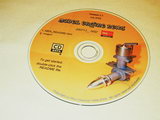
The response to my call for expressions of interest on the Model Engine News CD Collection last month was encouraging. As I really should have expected (being a software engineer), ironing out the last glitches in the setup procedure and instructions took a lot longer than anticipated. In fact, it may never be done to my total satisfaction, but I hope it is close enough now for general release.
If you emailed me when I optimistically called for expressions of interest last month, you will soon receive an email telling you how to proceed—should you still wish to. I discovered some large, forgotten, useless zip files hiding in the master directory tree that could be deleted, so the first release will be complete up to and including this (September '05) Editorial, and still have the Big Cookie.
This site contains three areas where pages are dynamically constructed to satisfy requests. These are the Engine Finder, the Site Search, and two advanced features on the Engine Review Index Page. To make them work requires a web server, and setting up one of these is not trivial to everybody. My feelings were that the Engine Finder was essential to get the full benefit of this site, while the others were merely nice to have. So a change was introduced to the Engine Finder to allow it to run totally in your Web Browser (using ECMA Script). My hope is that CD users will still receive high value from their purchase even if they choose not to try setting up a local server to enable the other features to run. Time will tell...
For those who are curious what they may be getting into, I've put the current setup instructions on line here. Visit the link at the start of this paragraph for ordering information.
AEHS Assists Researchers
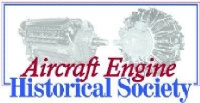
Regular readers will almost certainly be aware of the Aircraft Engine Historical Society (AEHS). The President of the Society, Mr Kimbal D McCutcheon, has asked me to let everyone know that they have launched an on-line facility to assist engine researchers access the US Air Force Engineering Division archive. To quote from Kim's press release:
Despite being one of the world's best sources of aviation history, and available at no charge to anyone visiting the National Archives II, the collection of records is extremely difficult to use because it lacks an effective finding aid. Unlike libraries where researchers can browse among the stacks of books, archives require that researchers request the specific boxes of material they wish to view. Archives staff members then retrieve the requested material, which must remain in a secure "reading room" while in use. There is a subtle "Catch-22" here. One must know exactly what box to request, even if one does not know exactly what box to request! Finding aids, which are similar to library card catalogues, theoretically address this problem. But in the case of the Engineering Division Records, the finding aids are, to put it nicely, just awful. Imagine a telephone directory organized by telephone number. You would have to read the whole thing to find your friend's number! This is the essential problem with the existing Engineering Division finding aid. One now has to view all 8,400 Microfiche images to find all occurrences of the subject being researched! One is reminded of the scene in Raiders of the Lost Ark where priceless antiquities disappear into the anonymity of endless shelves.
The art of designing a non-trivial web form to facilitate "resource discovery" is, as our research here has demonstrated, non-trivial itself! The solution that Kim and his volunteers have devised bears a remarkable resemblance to one of our designs (great minds at work here, for sure...) You can read more about this effort by clicking the AEHS logo above.
EMBEE and the PMC Imp
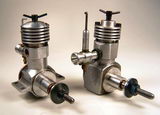
The picture here shows a pair of low production volume English engines. Left to right, they are an EMBEE and a PMC Imp. Although pictures of both already exist in the Engine Finder, I thought many of you would enjoy seeing these as well. The engines are of 0.75cc displacement and share more than a degree of similarity. A spot of restoration work on an Imp being undertaken by Motor Boy Ken Croft sparked a flurry of emails last month under the thread title "Is this the most horrible..." and the observation that if it were put in a model, he'd feel compelled to fully cowl it simply to hide it! Bert Streigler (whose engines are pictured here) goes one further, saying he'd be ashamed to fly unless he ran it with a rag wrapped around it. The EMBEE on the other hand is quite attractive and well finished. Remarkably, both engines are well behaved and perform quite nicely.
The EMBEE was made in Leicester by Moore and Bailey. It is a bar-stock engine, and by all reports, quite nicely made and finished, inside and out. The PMC Imp on the other hand is, to put it mildly, a trifle crude.
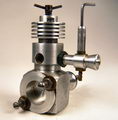 It was made by Peter Moore (on the Isle of Mann) and may have used some parts left over from the EMBEE (for more information on Peter Moore, see the ME Heron page).
Hidden away in the rather large exhaust opening are two tiny drilled ports in the liner. These have been cunningly positioned so as to be half closed off by the edge of the gigantic hole in the case (the choice of two smallish holes is probably provide a central "bar" of liner that gives the floating wrist pin something to ride on).
A design aspect not at all obvious from this rear view is the fact that, on this example, the backplate is retained by squashing it up against the bulkhead by the clamping action of the mounting screws!!!
It was made by Peter Moore (on the Isle of Mann) and may have used some parts left over from the EMBEE (for more information on Peter Moore, see the ME Heron page).
Hidden away in the rather large exhaust opening are two tiny drilled ports in the liner. These have been cunningly positioned so as to be half closed off by the edge of the gigantic hole in the case (the choice of two smallish holes is probably provide a central "bar" of liner that gives the floating wrist pin something to ride on).
A design aspect not at all obvious from this rear view is the fact that, on this example, the backplate is retained by squashing it up against the bulkhead by the clamping action of the mounting screws!!!
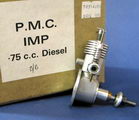
Other versions exist where the backplate extends beyond the case to form a mounting flange. And although "machined" all over, not all cases are bar-stock, some being a rather porous casting.
To confuse matters, there was also a ball bearing PMC Imp (pictured here from David Owen's collection).
The front crankshaft journal of both the Imp and EMBEE is turned separately and glued into the case with Araldite (I'll spare you another series of exclamation points—I seem to have used all my quota for the month).
The big surprise is that despite all the crudity, the Imp runs well, so it will duely get the CAD treatment as an MBI plan. We should also note that the Imp's "true side-port" feature was later used on the ML Midge; an engine most popular with first-time home constructors, which neatly leads us to...
Speaking of which...
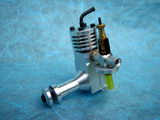
While on the topic of the ML Midge, here's a nicely finished example by Jim Woodside, a retired academic living in England. The needle valve appears to be a commercial item (judging by the stamped clicker), not that that's a bad thing. I particularly like the effort Jim has gone to, blacking the comp screw to harmonize with the head screws. I believe this may be his first engine—well done!
New Gallery and Finder Entries


Bliss! Twins galore! Photos received from Germany and England this past month are now featured on Page 6 of the Engine Gallery. There you will find details about Siegfried Fleischmann's opposed twins and his Cox-based two-stroke radial, plus an outstanding four-stroke V-twin diesel by Phil Cox. Some details that hint at the talent of these two gentlemen accompany each.
I have also added new entries in the Finder. Some are just quick links to engines which have appeared in reviews yet somehow missed having an entry added to the Engine Finder, but there are some genuine new additions as well. Search out the ED Hunter, Ivor F's Sesqui, McCoy 60 glow, Miles Special, PB 03, some G-Marks, a HP diesel, the Atlas ignition, and observe the strange family resemblance between the latter two. Many of these just beg for a more in-depth treatment. Someday...
HH Groves Revisited
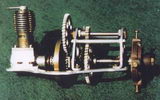
During the fix-up program for broken links conducted in preparation for the MEN CD, I came across a page that I'd completely forgotten about. The page provides some background on a (ahem) forgotten pioneer, Mr HH Groves. Now if the author can forget a page exists, what chance does a casual visitor stand? So the page on Groves has been expanded and linked from the People tag on the navigation menu at the left. Steam fans will certainly appreciate this link.
New Books and Magazines This Month
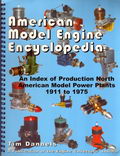
Last Month, I mentioned the new publication from Engine Collectors' Journal editor, Tim Dannels. Tim moved heaven and earth to get a review copy to me before 'press time', but while he may have some sway with these worthy institutions, it seems nobody but nobody can influence the US Mail. So despite Express International postage and two weeks of lead time, my review copy arrived 30 minutes after the August page of Model Engine News went live. Oh well, at least this way, Tim gets two plugs for the price of one!
The American Model Engine Encyclopedia, by Tim Dannels, Country View Enterprises, 2005, ISBN 0-97674541-0-X, is available for $49.95 plus $5.50 post and handling (extra outside the USA) from:
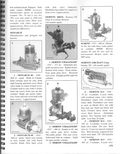
The AMEE is spiral bound (wire), containing, by my count, 311 glossy pages. It is professionally printed and profusely illustrated (about 1,700 pictures, drawings and illustrations Tim says). An introductory section describes how and why the book was created. In this section, Tim acknowledges sources and explains his policy on engine pricing: forget it! Any engine is worth what you will part with in order to own it. Trying to "value" an engine is bound to result in disappointment to one party or the other, and probably make them both mad at you! So you will not find any indication of "price" in the AMEE. What you will find is a very, very comprehensive alphabetical listing by supplier of virtually all of the engines manufactured in the United States of America over the period 1911 to 1975. For each manufacturer, engines are presented in chronological order with text describing the engine and it's distinguishing features. In most cases, the text is accompanied by a photograph. Three sections deal with internal combustion, expansion (CO2), and reaction (jet), although a number of expansion engines have leaked into the IC section in order to fully cover a manufacturer's range of products (mostly  ). The AMEE concludes with an comprehensive index.
). The AMEE concludes with an comprehensive index.
Tim's undertaking significantly expands on a similar effort to alphabetically catalogue American model engines that had begun in ECJ issue #60 of May-June 1976. This series ran through to issue #78, February 1985. This looks like a long time, but Tim recalls that issues were sporadic during this period. Anyway, I'd advise even those with a full set of ECJ to get hold of the AMEE. You will recognize some of the diagrams—such as which McCoy needle valve should appear on which model—but the coverage includes makes and models I don't recall ever seeing in the Journal, and having everything indexed and bound together is so much more convenient. Highly recommended.
Engine Of The Month: Gannet 15cc Four-stroke
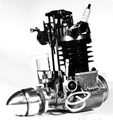
The subject for a closer look this month is a British marine four-stroke that is not all that well known (outside the circles that know it very well  ), namely the Gannet engines designed by George Nurthen. I've received a number of emails asking what it is, so after the Google-bot has done it's trick with the new page, a web search should yield results and save me some email traffic. In his Model Boats review of the engine, Peter Chinn notes that the Gannet had succeeded in the market while the earlier, but equally well made Channel Island Special marine four-stroke had not. Guess timing is everything (ouch, excuse bad pun...)
), namely the Gannet engines designed by George Nurthen. I've received a number of emails asking what it is, so after the Google-bot has done it's trick with the new page, a web search should yield results and save me some email traffic. In his Model Boats review of the engine, Peter Chinn notes that the Gannet had succeeded in the market while the earlier, but equally well made Channel Island Special marine four-stroke had not. Guess timing is everything (ouch, excuse bad pun...)
Tech Tip of the Month

This month's Tech Tip comes from Motor Boy Bert Streigler. It is so brilliant that it needs no words except praise. I hate to think how many hours I've spent making pin spanners and jigs to ensure that the holes match the pin spacing. This simple gadget solves all the problems forever.
 Second tip for the month comes from Mr Alwyn Smith, a retired Airbus skipper and life-long modeler. Alwyn was very much a mentor to me back in the early 60's, providing encouragement, advice and transport for my first successful single channel R/C adventures (in the days when our super-regen receivers had vacuum tubes in them and escapements were driven by rubber bands). He also astounded me by conclusively demonstrating that an OS Pet 09 could be made to: (1) actually run; and (2) pull a Ron Moulton designed Rascal through horizontal eights with ease—it being well known in my circle of friends that these accomplishments were respectively unlikely and impossible.
Second tip for the month comes from Mr Alwyn Smith, a retired Airbus skipper and life-long modeler. Alwyn was very much a mentor to me back in the early 60's, providing encouragement, advice and transport for my first successful single channel R/C adventures (in the days when our super-regen receivers had vacuum tubes in them and escapements were driven by rubber bands). He also astounded me by conclusively demonstrating that an OS Pet 09 could be made to: (1) actually run; and (2) pull a Ron Moulton designed Rascal through horizontal eights with ease—it being well known in my circle of friends that these accomplishments were respectively unlikely and impossible.
While chatting about control line models recently, we both agreed that the business of matching prop size, intake area, and tank location seemed to be very poorly understood. Alwyn said he'd written down some observations on this topic and offered them to me for these pages. Knowing I was behind in my preparations for the September Model Engine News page, I naturally leapt at the offer. So click the photo of my circa 1963 Junior 60, or follow this link for Alwyn's dissertation on Venturis.
Photography
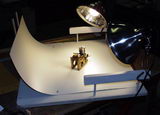
Most of the best engine photographs on this web site came from Motor Boy, Bert Streigler (TX). Bert's work is typified by the lack of shadow and the clean background. The photograph of the EMBEE and PMC Imp in this issue is a good example of Bert's work. While looking for another shot entirely, I chanced across a shot Bert sent in years ago of the simple setup he uses to photograph his engines. Being blessed with a bit of space in his modeling barn (situated beside his private R/C flying field), Bert's lighting table can stay permanently setup and ready for use. Of course, knowing what one is doing with a camera probably helps too...
IC in ME
No, Ron is not having more ROM inserted to assist with failing powers of recollection, rather the Model Engineer has (re)started a regular column on Internal Combustion, appropriately called I/C Engine Topics. The column name gives a passing nod to Edgar T Westbury's old Petrol Engine Topics column of days long past. It began in the June 10-23 issue (Volume 194, Issue 4249) under the by-line "Nemett". Unless this was a typo, I assume this to be Malcolm Stride, judging by provenance on the Schillings OHV in-line four featured in the first column. The ME takes a while to arrive Downunder, so readers in England will know all about it by now. It will be interesting to see how the feature develops. And it's good to see what I have for a while perceived as a growing world-wide focus on IC engine building reflected in ME editorial policy.
 CD Update
CD Update
 AEHS Assists Researchers
AEHS Assists Researchers
 EMBEE and the PMC Imp
EMBEE and the PMC Imp
 Speaking of which...
Speaking of which...
 HH Groves Revisited
HH Groves Revisited
 New Gallery and Finder Entries
New Gallery and Finder Entries
 Photography
Photography
 IC in ME
IC in ME
 Editorial
Editorial
 New Books and Magazines This Month
New Books and Magazines This Month
 Engine Of The Month: Gannet 15cc Four-Stroke
Engine Of The Month: Gannet 15cc Four-Stroke
 Tech Tip of the Month
Tech Tip of the Month
 Standard Stuff
Standard Stuff
 !
!














